|
The
font is octagonal and dates from the 14th Century. It's
somewhat worn and patched together. This is the font where
countless generations of local people have begun their Christian
journeys through life. We can imagine the babies from the families
of the Earls of Roden, or Viscount Jocylin or Sir William Hewyt or
the Wisemans being baptised here and we can imagine the infants of
ordinary farmers and shopkeepers too.
Nearby
we see some more stained glass:

This
window was installed in 1884 in memory of a Mrs Hiley of Hyde Hall
and shows the feeding of the five thousand. The original medieval
stained glass in all the windows was removed by the Puritans and
replaced by plain glass.
Below
the window is a 17th Century oak chest. The story goes that it was
used as a coal bunker for part of its life!
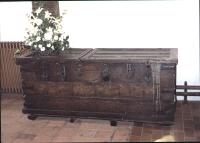
Now
we come to the first of the stone monuments. It is big. About
twelve foot tall. It's a painted alabaster tomb of Sir John
Leventhorpe, 1st Baronet 1560-1625, his wife Joan (d.1627) and
their many children.
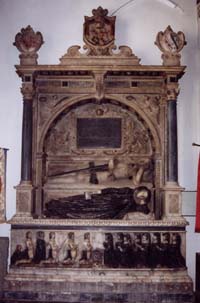 The
children are along the bottom. From the left there is first the
son who died in infancy, then five more sons and eight daughters.
The son dressed in black is said to be the one who went into the
priesthood.
The
children are along the bottom. From the left there is first the
son who died in infancy, then five more sons and eight daughters.
The son dressed in black is said to be the one who went into the
priesthood.
Click
here to see what the church looked like in 1824.
All
this so far has been in the South aisle (the part of the church
through the arch on the right of the picture below).
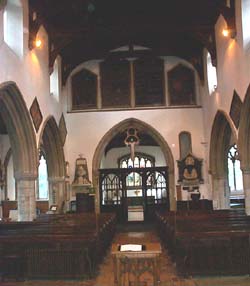 The
central part or nave, has walls that are 13th Century, the screen
is 15th Century and some of the pews are early 16th
century.
The
central part or nave, has walls that are 13th Century, the screen
is 15th Century and some of the pews are early 16th
century.
The
four panels over the rood screen, containing the Lord's Prayer,
The Apostles' Creed and the Ten Commandments, were all made by the
family of A. [Arthur] Wiseman, Vicar's Warden, and presented to
the church in 1878. They were taken down and restored as part of
the Millennium project in 2000.
Behind
us is the tower and the organ
Click
here to hear the organ (160kB mp3)
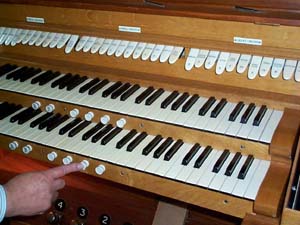
Inside
the organ loft with former Organist and Choirmaster Keith Hall,
showing the range of pipe sizes:
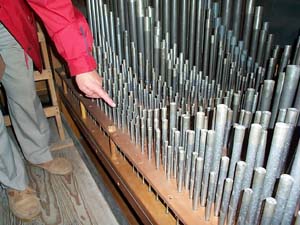
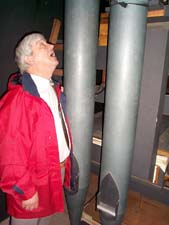
Also
at the back of the church there is some medieval
graffiti:

The
stained glass window in the north aisle was also placed there by
A. Wiseman in 1882 before he went to Australia to live in a house
called 'Sawbridgeworth'.

The
pews must have seemed quite hard for the congregation when
sermons were much longer than they are today. The pulpit is
Jacobean oak..
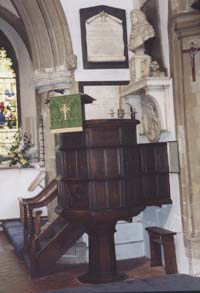
Today's
preachers have the bust of Robert, Viscount Jocelyn (1688-1756),
Lord Chancellor of the Kingdom of Ireland, looking over their
shoulders at them, complete in Chancellor's robes and wig.
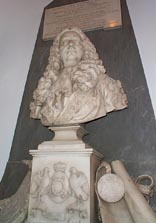 click on picture for an enlargement
click on picture for an enlargement
Behind
the lectern is the marble monument to Sir William Hewyt and his
wife Elizabeth (d. 1646).
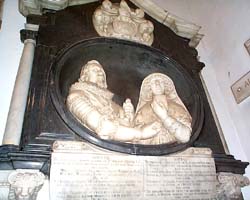
Here
are the arms of Thomas Hewett of Sayesbury (1635). If you click on
them you can find out a lot more about the families who lived at
Shingle Hall, Hyde Hall, Pishobury, Manor of Groves, Tednambury
and Sayesbury....
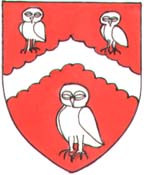 Click
Click
Great
St Mary's has seven 'hatchments' (painted diamond shaped wooden
armorial panels). It's most unusual to have that many.
There
were helmets too, like this one (now at Hertford Museum) :
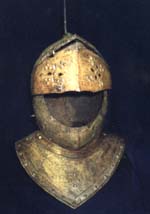 Click here to see more
Click here to see more
Did
you know Great St Mary's has a crypt? Click
here to find out more...
To
the left of our viewpoint in the Chancel, is the 14th Century
North Aisle with its 20th Century Memorial Altar dedicated to
those who lost their lives in the world wars. There is another
fine stained glass window:

Now
we go to the Chancel, which is in front (to the East) of the nave.
It
is originally 13th century but has been renewed over the years.
The southern arch is twelfth century. The high altar is flanked by
the battered tomb of Sir John Jocelyn and his wife 'Philip' - it
was recorded by an historian in 1763 as already being
'mutilated'. There is also a carved canopied tomb
which is very similar to one in Westminster Abbey:

Sir
Walter Myldemaye and his wife Marie (1605/6) and their son Tom
kneel to say their prayers.
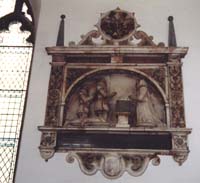
Next
comes the huge monument to George, Viscount Hewyt of Gowram:
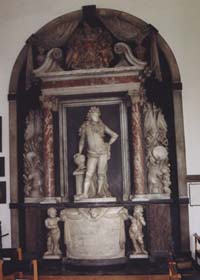
Nearby, on the floor, under a
carpet to protect it, is the brass of Sir Jeffrey Jocelin (d.
1470) and his two wives, Katherine and Joan.
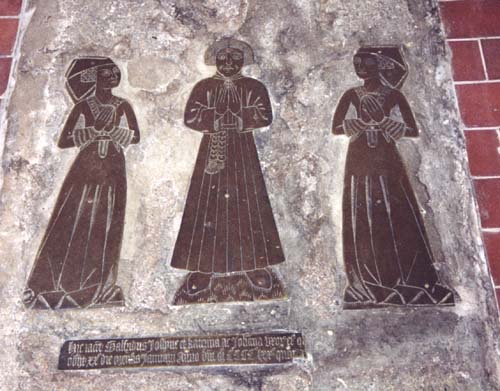
Let's
now go BRASS RUBBING....
PLEASE
CLICK HERE
|



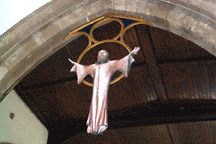










 click on picture for an enlargement
click on picture for an enlargement
 Click
Click Click here to see more
Click here to see more


